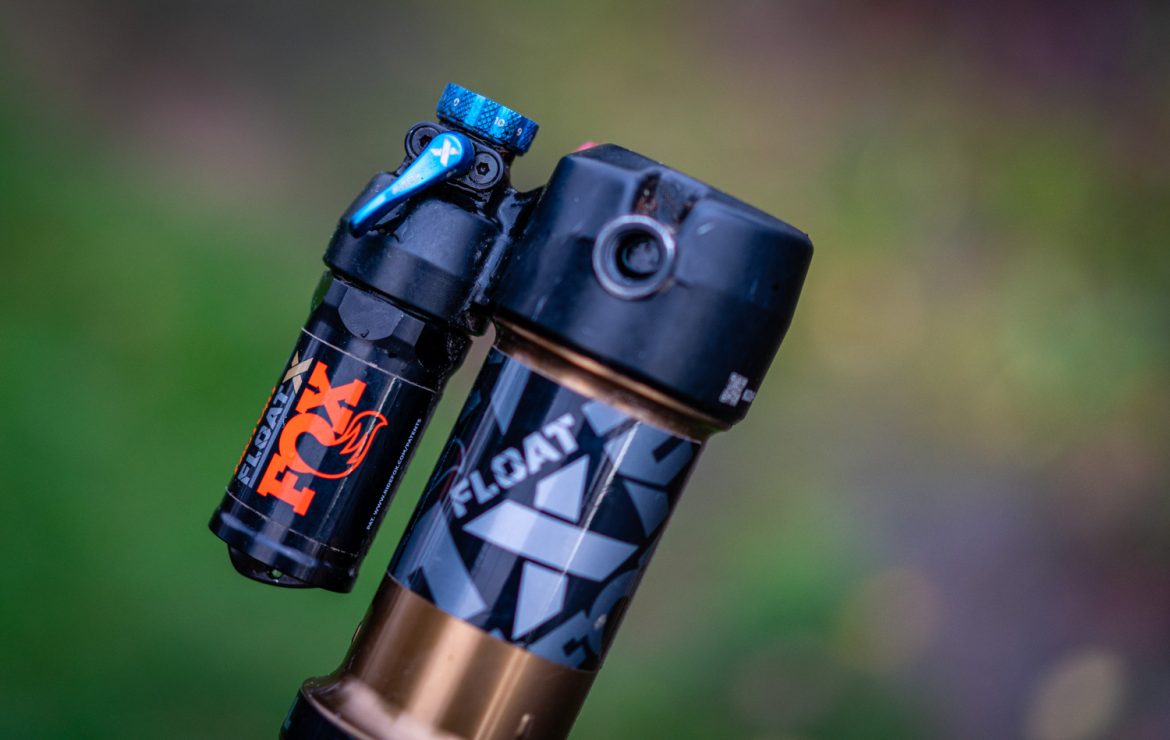
We don’t often get the chance to test new air shocks, particularly ones that replace the beloved Fox DPX2. This latest Float X shock takes a lot of the best bits from the DPX2 and makes them better, all while keeping it a step below the Float X2 air shock in both weight and intentions. The new Float X receives an enlarged air can for a more supple initial stroke, and Fox says that this also drops the necessary air pressure in the shock by roughly 40psi. The main piston also grew to make space for better oil flow and regulation inside. The compression and rebound circuits are now separated so that adjustments to one don’t affect the other, and there’s a bottom-out bumper at the base of it all to help eat up those harsher hits.
Float X shocks are only available in metric sizing, retailing for around $599 with Kashima coating and $519 when they wear black coats. Imperial shock sizing will still be covered by the trusty DPX2 and X2 models.

Setup with the Float X is a breeze, with a single low-speed compression knob with 11 clicks of adjustment and a low-speed rebound knob with 18 clicks for the fiddling. The knobs are now labeled so you can quickly adjust and reset them when you want to play around with different setups. The Raaw Madonna I tested this shock with has a high initial leverage ratio, so I had to pump it nice and high to achieve proper support. The air can filled far beyond my body weight number in pounds per square inch of pressure, and it took a few rides before It was pumped to the sweet spot.
I tried a variety of volume spacers in the shock but ended up going back to the stock spacer to keep the bike a little more linear. The Float X accepts a wider range of spacers than its predecessor with smaller increments between them to allow for a nice and precise setup. Swapping spacers in the shock is as easy as any. Just release the air pressure, loosen the air can by hand or with a strap-wrench, and slide the can down to reveal the spacer seats.

I started off with the compression roughly half shut, and the rebound a few clicks faster than the midpoint, and it has felt great since. I did recently speed things up by a click to compensate for the chilly weather and requisite thickening oil, and there seems to be ample adjustment on both clickers. Folks who like their suspension wicked fast will have no trouble finding that rabbit with the Float X, and anyone looking for pure composure has an even wider range to choose from.
There’s a lockout for the against-gravity portion of your ride, and it does well to firm up the rear wheel and make things feel more efficient. It’s not a fully-blocked lockout, and it does let the rear tire track the trail better than a hardtail. The switch only has two positions, so you can flip it open when you drop the saddle and forget about it until the next long pedally bit. Given the higher pressure I run in this shock I have seldom needed to use the climb switch unless I was on a paved road climb, which is rare here in Bellingham. On rooty climbs, the shock feels better wide open and ready to give some grip.
In addition to its shiny dials and hazy-beer-tinted coating, the Float X dropped 360g from my test bike compared to the Fox DHX coil shock. While not a full pound, that’s a substantial amount of weight savings, and it’s one that air-spring fans know well.
My recent comparison shock to weigh this one against is coil sprung, and the Float X holds a line quite well compared to a steel-sprung shock that’s known for traction first. I was surprised by how smooth and easy the first third of its travel feels, providing grip while keeping the rider’s eyeballs firmly in their skull. The Float X feels smoother and more composed than a DPX2, and the separated circuits do well to dial in the ride over trail chatter. The days of adjusting the rebound to then find the compression needing some clicks are likely over with shock designs like this one, and I’d say it’s true good riddance.
I would put the mid-stroke support rating for the Float X someplace in the middle. It’s not mind-blowingly supportive like a race-tuned shock, nor does it slouch through the middle third of its travel. The shock holds the rear of the bike up in its travel register decently well, while it does feel a little more tuned for comfort than pure performance — which makes good sense given that most buyers are likely not racing at a high level. Folks who prefer a stronger rabbit between their legs can add all the volume spacers available, but if you like fewer spacers the mid-stroke will suffer slightly. I ended up getting used to the shock’s progressive curve and enjoyed the heftier push back toward the end of the mid-stroke.


Bottoming out the Float X has been a regular occurrence, and if I wanted to ride with it on burlier singletrack than the Galbraith and Chuckanut town tracks here in Bellingham I would definitely click another volume spacer into place. There are a few meter-high drops on the mountain, and I managed to clap the bottom-out bumper almost once per ride. The bumper does well to mute the slamming alloy sound, and the end of the stroke pops back with a lovely force to get you out of compressions and to ready itself for the next root. With the shock set up a little fast, I didn’t experience any packing, and it seems to pick itself up quickly after successive jabs and uppercuts.
A high-speed compression adjuster on this shock wouldn’t make anyone sad, but that’s what you get with the higher-end Float X2. It’s not something the Float X needs, but on longer DH trails with successive large impacts, it would be cool to have that additional tuner. Maybe it’s just the tinkerer in me, but I’d love to see all shocks have all of the adjustability. Even the least expensive options.

Pros and cons of the Fox Float X Factory air shock
Pros
- Seperate circuits for compression and rebound
- Consistent feel on long descents
- Wide ranging air spring adjustment
Cons
- A high speed compression knob would be a nice addition
- Kashima doesn’t seem necessary. I would go for the less expensive Performance Elite version.
Conclusion
If you want a rabbit-ready air shock that’s lightweight and ready for relatively heavy riding, this one will do the trick and more. As long as you don’t feel the need for high-speed adjustments it has your tuning time covered, and the enlarged air can can be dialed in to fit almost any riding style.
- Price: $599 (Kashima)
- Available at Jenson USA and other online retailers






















4 Comments
Jan 8, 2022
Mar 3, 2022
Mar 4, 2022
Mar 4, 2022